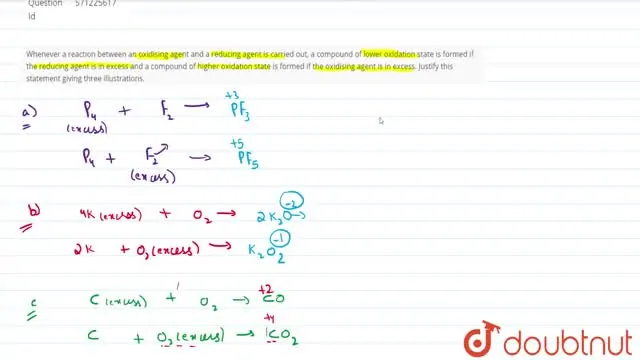Whenever a reaction between an oxidising agent and a reducing agent is carried out, a compound of lower oxidation state is formed if the reducing agent is in excess and a compound of higher oxidation state is formed if the oxidising agent is in excess. Justify this statement giving three illustrations.
Whenever a reaction between an oxidising agent and a reducing agent is carried out, a compound of lower oxidation state is formed if the reducing agent is in excess and a compound of higher oxidation state is formed if the oxidising agent is in excess. This can be illustrated as follows:
(i) P4 and F2 are reducing and oxidising agents respectively .
If an excess of P4 is treated with F2 , then PF3 will be produced , wherein the oxidation number (O.N.) of P is +3 .
P4 (excess ) + F2→+3PF3
However, if P4 is treated with an excess of F2, then PF5 will be produced, wherein the O.N. of P is +5.
P4+F2(excess)→+5PF5
(ii)K acts as a reducing agent, whereas O2 is an oxidising agent.
If an excess of K reacts with O2, then K2O will be formed, wherein the O.N. of O is –2.
4K (excess ) +O2→2K2−2O
However , if K reacts with an excess of O2 , then K2O2 will be formed , wherein the O.N. of O is −1 .
2K + O2(excess)→K2−1O2
(iii) C is a reducing agent , while O2 acts as an oxidising agent .
If an excess of C is burnt in the presence of insufficient amount of O2 then CO will be produced . wherein the O.N. of C is +2 .
C (excess ) + O2→+2CO
On the other hand , if C is burnt in an excess of O2 , then CO2 will be produced , wherein the O.N. of C is +4 .
C+O2(excess)→+4CO2
Related Playlists
- BOOK - NCERT ENGLISHCHAPTER - REDOX REACTIONSEXERCISE - EXERCISE30videos
REDOX REACTIONS
- BOOK - NCERT ENGLISHCHAPTER - ORGANIC CHEMISTRY- SOME BASIC PRINCIPLES AND TECHNIQUESEXERCISE - EXERCISE40videos
ORGANIC CHEMISTRY- SOME BASIC PRINCIPLES AND TECHNIQUES
- BOOK - NCERT ENGLISHCHAPTER - SOME BASIC CONCEPTS OF CHEMISTRY EXERCISE - All Questions45videos
SOME BASIC CONCEPTS OF CHEMISTRY
Similar Questions
Differentiate between an oxidizing agent and a reducing agent.
View SolutionCan PCl5 act as an oxidising as well as a reducing agent? Justify.
View SolutionDefine oxidation, reduction, oxidising agent and reducing agent in terms of oxidation number.
View SolutionWhich oxide of sulfur can act as an oxidising as well as a reducing agent ?
View SolutionThe compound that can work both as oxidising and reducing agent is
View SolutionThe compound that can work both as an oxidising as well as reducing agent is :
View SolutionDifferentiate between Reducing and oxidizing agents
View SolutionSulfur dioxide acts as an oxidising agent as well as a reducing agent. Give one reaction each to show its oxidising nature and its reducing nature.
View SolutionAn element in its lowest oxidation state can act only as an oxidising agent.
View SolutionAssertion :- Nitrous acid (HNO2) may act as an oxidising agent as well as a reducing agent.
Reason :- The oxidation number of Nitrogen remains same in all the compounds.View Solution


